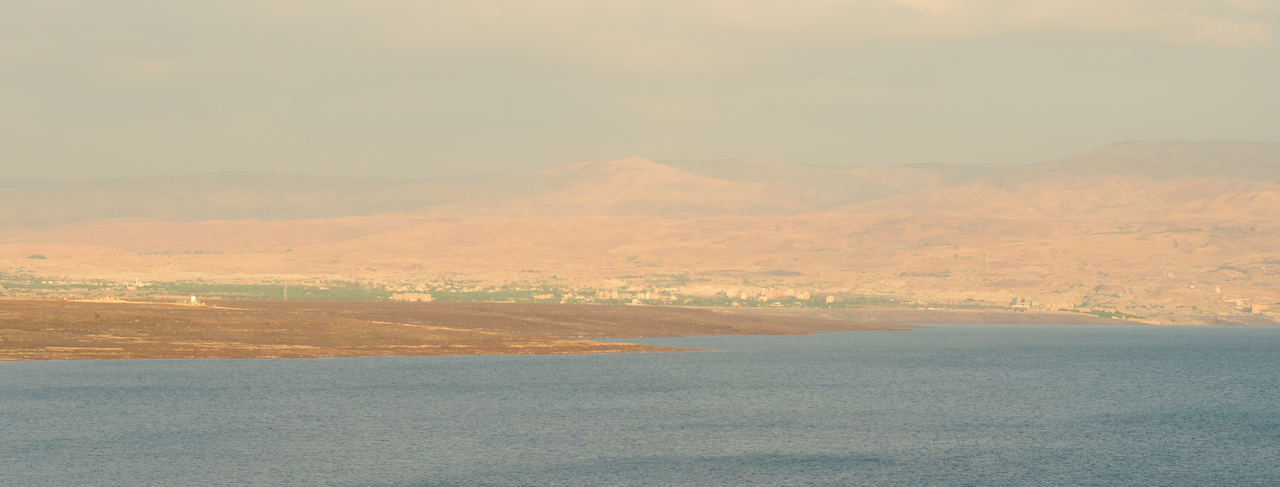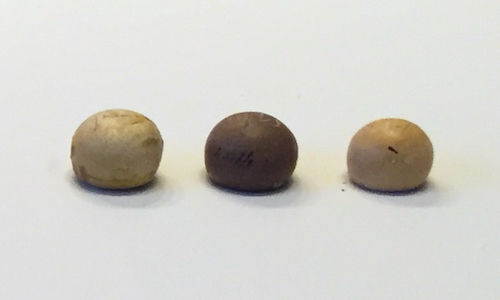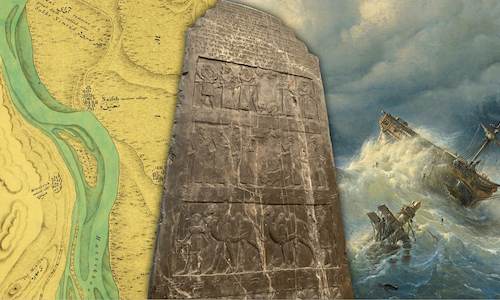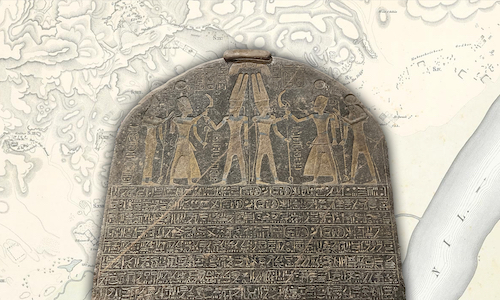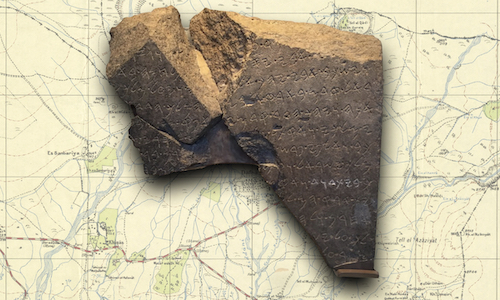Israelite Origins: Biblical counter-narratives
As we saw in the last post, the narrative found in Joshua that explains how the Israelites came to be in Canaan does not stack up with the archaeological evidence; in fact, it’s completely contradicted by it. The glorious conquest of Canaan and complete annihilation of its indigenous people described in Joshua 10-11 quite plainly did not happen – this is a bit difficult for those who work on the assumption that a plain reading of the biblical text provides reliable historical information. However, if your faith requires scripture to be “true” (read, “historically accurate”) then this discrepancy between the conquest narratives and the archaeological evidence pales into insignificance when it’s pointed out that scripture lacks internally consistency in its narratives of Israelite origins.
We’ve touched on this topic a couple of times before:
- We’ve previously seen that Judges 1:1 places the beginning of the conquest in the period shortly after Joshua’s death, implying that Joshua didn’t take part in the conquest, never mind lead it.
- We’ve also seen that 1 Chronicles 7:20-29 contains a tradition that Ephraim and his descendants never went down to Egypt; they were in Canaan the whole time running failed cattle-rustling missions down to Gath, with Ephraim’s grand daughter building Beth-Horon.
Neither of these narratives fit what Joshua 10 and 11 tell us about the origins of Israel in Canaan. In this post we’ll take a look at a few more of these counter-narratives. Let’s start with the least threatening passages.
A mixed multitude
Taking the Exodus record at face value, we find that the Israelites were not alone when they left Egypt:
Ex 12:37–38 The Israelites journeyed from Rameses to Succoth, about six hundred thousand men on foot, besides children. A mixed crowd also went up with them, and livestock in great numbers, both flocks and herds1
So, at the very least, scripture tells us that the group that came out of Egypt were not of a single, “pure genetic stock” when they left Goshen; presumably the same “mixed” group arrived in Canaan too – there’s no mention of this mixed crowd leaving or turning back halfway through the Exodus wanderings.
The Israelites were also joined by Rahab and her family:
Jos 6:25 But Rahab the prostitute, with her family and all who belonged to her, Joshua spared. Her family has lived in Israel ever since.
…and by the Kenites:
Jdg 1:16 The descendants of Hobab the Kenite, Moses’ father-in-law, went up with the people of Judah from the city of palms into the wilderness of Judah…
So, according to scripture the Israelites weren’t alone in Canaan; at the very least Rahab’s extended family, the Kenites, and the mixed multitude were there too.
How did the conquest go?
Wading in a little deeper, let’s take a look at some passages that cast a different light on the Israelite conquest.
Firstly, the record of Joshua 10 and 11 is clear: the conquest was swift:
Jos 10:42 Joshua took all these kings and their land at one time, because the LORD God of Israel fought for Israel.
Scripture provides a number of counter-narratives to this description of the conquest, a couple of them being in these very two chapters! The first example comes from Joshua’s encouragement to the Israelite army to continue pursuing their enemies:
Jos 10:20 When Joshua and the Israelites had finished inflicting a very great slaughter on them, until they were wiped out, and when the survivors had entered into the fortified towns…
See that? The enemy were “wiped out”, but the verse continues to talk about survivors! Which is it? Were Israel’s enemies wiped out, or weren’t they? Make no mistake, “wiped out” means a complete end, or, completeness, a totality without any diminution2 – the same word is used in Numbers where God says,
Nu 14:35 I will do thus to all this wicked congregation gathered together against me: in this wilderness they shall come to a full end, and there they shall die.
So, the enemy army which had been completely wiped out, which had come to a full end… had survivors enough to be mentioned alongside their very annihilation! Far from being immediately annihilated, we’re told there were survivors.
Another counter-narrative embedded in the record of complete conquest that occurred “at one time” is this sentence in the summary of the southern campaign:
Jos 11:17–18 He [Joshua] took all their kings, struck them down, and put them to death. Joshua made war a long time with all those kings.
Instead of the lightning quick conquest we find that the war to conquer Canaan went on “a long time”. This counter-narrative matches up nicely with other passages in Joshua that indicate that the conquest wasn’t even nearly complete by the end of Joshua’s life, and that plenty of Canaanites seemed to still be hanging around, e.g.
Jos 23:6–7 …be very steadfast to observe and do all that is written in the book of the law of Moses, turning aside from it neither to the right nor to the left, so that you may not be mixed with these nations left here among you…
Little by little
Here are another couple of passages that explicitly state that the conquest would take a very long time:
Ex 23:29–30 I will not drive them out from before you in one year, or the land would become desolate and the wild animals would multiply against you. Little by little I will drive them out from before you, until you have increased and possess the land.
Dt 7:22 The LORD your God will clear away these nations before you little by little; you will not be able to make a quick end of them, otherwise the wild animals would become too numerous for you.
The first one particularly indicates that this was a process that would take generations. It was to be no swift conquest that would give the land to the Israelites.
Next let’s take a look at just what happened to the Canaanites. The narrative found in the northern and southern campaign is clear: Joshua annihilated them. Not a single Canaanite was left (Jos 11:20 cf. Deut 20:16–18). Yet, if that’s the case, what do we do with passages like these?
Jos 24:12 I sent the hornet ahead of you, which drove out before you the two kings of the Amorites; it was not by your sword or by your bow.
Here we find it explicitly stated that it wasn’t the Israelite army that had managed to wipe out the Amorites. In fact, the Amorites weren’t wiped out at all – they were driven out of the land instead. Hornet refugees.The point is repeated a few verses later:
Jos 24:18 …the LORD drove out before us all the peoples, the Amorites who lived in the land.
In fact, driving out rather than annihilating the Canaanites appears to have been both God’s command…
Ex 23:31 I will set your borders from the Red Sea to the sea of the Philistines, and from the wilderness to the Euphrates; for I will hand over to you the inhabitants of the land, and you shall drive them out before you.
…and his promise:
Ex 34:11 Observe what I command you today. See, I will drive out before you the Amorites, the Canaanites, the Hittites, the Perizzites, the Hivites, and the Jebusites.
For the avoidance of doubt, “driving out” isn’t a euphemism for annihilation or genocide; the term is the same as that used of Adam when God “drove out the man” from the garden of Eden (Ge 3:24), it’s used of the shepherds who “drove away” from the well the priest of Midian’s seven daughters (Ex 2:17), and it’s used to describe what Jephthah’s half-brothers did to him when “they drove Jephthah away” (Jdg 11:2).
What was the reason God gave for saying he would drive out the Canaanites “little by little”? The inference is that the Israelites were too small in number to be able to manage the whole land (see quotes above; Ex 23:29–30 & Dt 7:22). Though their small number is only inferred in those two passages, the point is made explicitly elsewhere:
Dt 7:6–8 For you are a people holy to the LORD your God; the LORD your God has chosen you out of all the peoples on earth to be his people, his treasured possession. It was not because you were more numerous than any other people that the LORD set his heart on you and chose you—for you were the fewest of all peoples. It was because the LORD loved you and kept the oath that he swore to your ancestors…
While we’re here, contrary to what some may want this passage to say “the fewest of all peoples” does not refer to the patriarchs who went down into Egypt, it refers to the people Moses is addressing on the Plain of Moab opposite Jericho as they were about to enter Canaan. It was that group that were said to be the fewest of all peoples. Trying to get rid of the “problem” of a small Israel by such furious handwaving is bad reading, and undignified.
This “fewest of all peoples” is a striking counter-narrative to the implied millions of Israelites in Numbers 1 and 26. If the Israelites really did number in the millions they really could have just walked in to Canaan, sat down, and owned the place by default! Of course, as we saw earlier in the series, there’s absolutely zero archaeological evidence of such an event, and plenty against it.
Annihilation of Canaanites vs. being a minority among them
Next let’s take a look at narratives that tell a different story about the power dynamics between the Israelites and Canaan’s indigenous people.
As we’ve noted numerous times, the conquest accounts of Joshua 10 and 11 when taken at face value read as if there wasn’t a single Canaanite left in Canaan by the end of the Southern and Northern campaigns:
Jos 10:40 So Joshua defeated the whole land, the hill country and the Negeb and the lowland and the slopes, and all their kings; he left no one remaining, but utterly destroyed all that breathed, as the LORD God of Israel commanded.
Jos 11:14–15 …but all the people they struck down with the edge of the sword, until they had destroyed them, and they did not leave any who breathed. As the LORD had commanded his servant Moses, so Moses commanded Joshua, and so Joshua did; he left nothing undone of all that the LORD had commanded Moses.
Bear in mind that if Joshua really did what Yahweh commanded Moses (“You shall annihilate them—the Hittites and the Amorites, the Canaanites and the Perizzites, the Hivites and the Jebusites”, Deut 20:17), all of Canaan would be empty.
As anyone who’s read the first few chapter of the book of Judges knows, it contains an altogether different narrative. The very first verse explains that the conquest that it goes on to describe began after Joshua’s death. Joshua wasn’t around to see it.
And, how did the Judges conquest go? Well, chapter 1 tells us that it started well enough – the tribe of Judah, at the command of God went up into Canaan with the tribe of Simeon. Thing went well for them, defeating Bezek, taking Jerusalem and setting it on fire, taking Hebron – a victory attributed to Caleb’s younger brother Othniel – but from there it was all down hill. The Benjamites weren’t able to drive the Jebusites out of Jerusalem, Mannaseh couldn’t drive out the people of the various towns in in its territory but “the Canaanites continued to live in that land”, and Ephraim fared no better. The rest of the tribes are listed and are said to have “lived among the Canaanites” because they couldn’t or didn’t drive them out. The chapter ends with the disgraceful record of the tribe of Dan whose pathetic attempts left them not even able to live the undignified life of a minority in their inheritance – the Amorites “did not allow them to come down to the plain”.
The Judges conquest narrative paints a pretty bleak picture: it describes the Israelites as living as a scattered minority across Canaan withonly a negligible power base in the hills of Judah.3 This is not the conquest we read of in Joshua – it’s very much a counter-narrative.
What did this small, powerless minority do?
Jdg 3:5–6 So the Israelites lived among the Canaanites, the Hittites, the Amorites, the Perizzites, the Hivites, and the Jebusites; and they took their daughters as wives for themselves, and their own daughters they gave to their sons; and they worshiped their gods.
This passage describes wholesale Israelite assimilation – they intermarried with the Canaanites and they took on their religious practices. This would almost guarantee their complete disappearance into the larger Canaanite people. After only a couple of generations there would be no “Israel” to speak of.
The idea of wholesale assimilation was remembered all the way through to exilic times as late psalms attest:
Ps 106:34–35 They did not destroy the peoples, as the LORD commanded them, but they mingled with the nations and learned to do as they did.
Coming back to the topic of the various indigenous groups that the Israelites, according to the Judges record, had not been able to conquer, the writer of 1 Kings makes clear that this is not a situation which resolved itself:
1 Ki 9:20–21 All the people who were left of the Amorites, the Hittites, the Perizzites, the Hivites, and the Jebusites, who were not of the people of Israel — their descendants who were still left in the land, whom the Israelites were unable to destroy completely—these Solomon conscripted for slave labor, and so they are to this day.
These tribes are said to have remained among the Israelites up to the time the book of Kings was written. And that’s a very long time indeed. The Israelites always lived among those they were said to have annihilated; the counter-narrative of their wholesale assimilation was not forgotten either.
Origins of the Patriarchs
Now things get very uncomfortable – let’s look at counter-narratives covering the Patriarchs themselves, starting in Deuteronomy 26:
Dt 26:4–5 When the priest takes the basket from your hand and sets it down before the altar of the LORD your God, you shall make this response before the LORD your God: “A wandering Aramean was my ancestor; he went down into Egypt and lived there as an alien, few in number, and there he became a great nation, mighty and populous.”
This liturgical formula is considered by some to be very ancient – much more so than its surrounding text. A couple of quick summaries:
All the evidence points to the fact that this prayer is very much older, both in form and content, than the literary context into which it has since been inserted.4
This clause is probably very ancient, for it is unlikely that Israelite tradition would have chosen to describe Israel’s ancestors as “Arameans” once the Arameans of Damascus became aggressive toward Israel in the ninth century B.C.E.5
This ancient passage recalls that Jacob was an Aramean. Though his mother was an Aramean (“…Rebekah, daughter of Bethuel the Aramean of Paddan-aram, sister of Laban the Aramean…” Ge 25:20), Jacob himself was born and raised in Beer-lahai-roi the Negev, south of Canaan proper. His father Isaac had also been born in the Negev (Ge 20:1 & 21:23). Jacob therefore, at least according to the narratives in Genesis, was hardly Aramean and yet Deuteronomy 26:5 claims he was.
This counter-narrative is evidence of different – and very early – Patriarchal traditions6, which without doubt have a bearing on our understanding of Israelite origins.
It gets worse…
Israelites originally Canaanites
The cherry on the counter-narrative cake is found in Ezekiel:
Ezek 16:1-3 The word of the LORD came to me: Mortal, make known to Jerusalem her abominations, and say, Thus says the Lord GOD to Jerusalem: Your origin and your birth were in the land of the Canaanites; your father was an Amorite, and your mother a Hittite.
Later in the chapter the point is reenforced:
Eze 16:44–46 …everyone who uses proverbs will use this proverb about you, “Like mother, like daughter.” You are the daughter of your mother, who loathed her husband and her children; and you are the sister of your sisters, who loathed their husbands and their children. Your mother was a Hittite and your father an Amorite. Your elder sister is Samaria, who lived with her daughters to the north of you; and your younger sister, who lived to the south of you, is Sodom with her daughters.
The writer could not be clearer: he locates Israel’s origins in Canaan. Not Ur. Not Haran. Not Goshen. Not Sinai. Canaan.
Bear in mind that the Amorites, at least in the conquest narratives of Joshua 10 and 11 were indigenous Canaanites:
Jos 10:5 Then the five kings of the Amorites—the king of Jerusalem, the king of Hebron, the king of Jarmuth, the king of Lachish, and the king of Eglon…
Jdg 1:35 The Amorites continued to live in Har-heres, in Aijalon, and in Shaalbim, but the hand of the house of Joseph rested heavily on them, and they became subject to forced labor.
The Hittites too in some passages appear to be a group in Canaan that long predated the Israelite conquest, e.g. we find mention of them as natives in the Abram narrative:
Ge 23:3–7 Abraham rose up from beside his dead, and said to the Hittites, “I am a stranger and an alien residing among you; give me property among you for a burying place, so that I may bury my dead out of my sight.” The Hittites answered Abraham, “Hear us, my lord; you are a mighty prince among us. Bury your dead in the choicest of our burial places; none of us will withhold from you any burial ground for burying your dead.” Abraham rose and bowed to the Hittites, the people of the land.
Quite simply, Ezekiel claims that the Israelites were natives of Canaan, descendants of native Canaanite peoples. They hadn’t come from elsewhere, they themselves were indigenous Canaanites.
Conclusion
The point of this post in the series is this: read as a flat text the Bible does not help us on the topic of Israelite Origins:
- On the one hand it tells us that the Patriarchs came from Ur or Canaan, on the other we’re told they were Arameans.
- On the one hand we’re told the Israelites wiped out everyone in Canaan and then settled it, on the other we’re told that most of the tribes failed miserably to take their inheritance.
- On the one hand there were millions of Israelites who entered Canaan, on the other they were “the fewest of all people”.
- On the one hand the Israelites annihilated the Canaanites in one go, on the other the Canaanites were driven out over a period of generations, partly by hornets.
- And, finally, on the one hand we’re told the Israelites were commanded to annihilate the Canaanites, and on the other we’re told they were Canaanites.
What should be abundantly clear is this: the Bible does not give us a straight story on how the Israelites emerged in Canaan. We can only conclude that its writers, compilers, and redactors weren’t interested in giving a straight story. Copyists of the biblical text had hundreds and hundreds of years to patch up and smooth out the record and produce a single coherent narrative, but they chose not to do so. Evidently, doing so wasn’t their interest either. It appears that ‘history proper’ was not anyone’s concern down through the ages. It’s only modern readers that try to force the Bible into being a history textbook – evidently not something its authors ever intended it to be.
To paraphrase that wonderful line from the Lord of the Rings, “Go not to the Bible for Israelite Origins, for it will say both no and yes.” Instead we must look to the evidence of archaeology if we want to know where the Israelite people came from.
Next in the series is going to be a few posts on what history tells us was going on in and around Canaan at the time of the Exodus and Conquest. To do that we’ll need to deal with what we’ve put off so far: “The Date of the Exodus”.
Featured image
The plain of Moab as seen from the north-western shore of the Dead Sea on a hot and hazy evening.
Footnotes
-
Unless otherwise noted all scripture quotes are from the New Revised Standard Version (Nashville: Thomas Nelson Publishers, 1989). ↩
-
See Ludwig Koehler et al., The Hebrew and Aramaic Lexicon of the Old Testament (Leiden: E.J. Brill, 1994–2000), 1752–1754, and B. Kedar-Kopfstein, “תָּמַם,” ed. G. Johannes Botterweck, Helmer Ringgren, and Heinz-Josef Fabry, trans. David E. Green, Theological Dictionary of the Old Testament (Grand Rapids, MI; Cambridge, U.K.: William B. Eerdmans Publishing Company, 2006), 700–711. ↩
-
We’ll revisit this last point in a future post in the series – the archaeological evidence isn’t nearly so positive about the people of Judah. ↩
-
Gerhard von Rad, The Problem of the Hexateuch and Other Essays (trans. E. W. Trueman Dicken; London: SCM Press Ltd, 1984), 4. ↩
-
Jeffrey H. Tigay, Deuteronomy (The JPS Torah Commentary; Philadelphia: Jewish Publication Society, 1996), 240. ↩
-
“Whatever the character of the Aramaeans in this connection it is evident that the biblical tradition places the patriarchal origins in the area from which the later Aramaeans came. Perhaps they were, in fact, one group of the widespread proto-Aramaeans.” J. A. Thompson, Deuteronomy: An Introduction and Commentary (vol. 5; Tyndale Old Testament Commentaries; Downers Grove, IL: InterVarsity Press, 1974), 279. ↩
